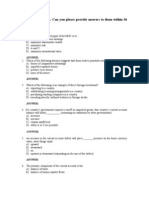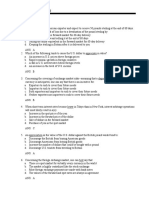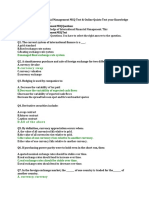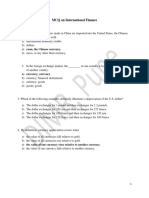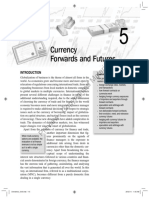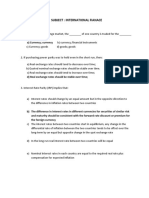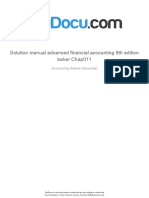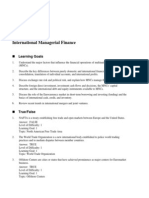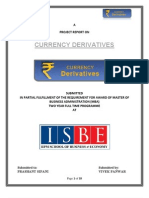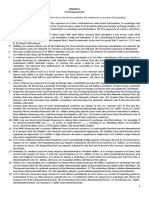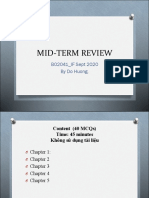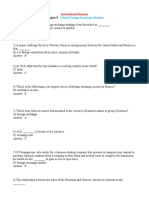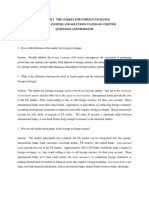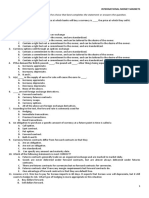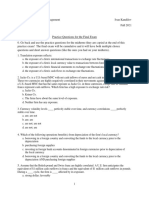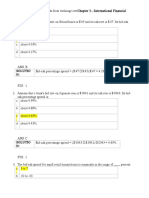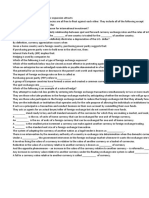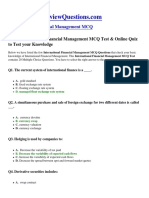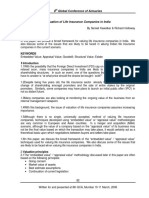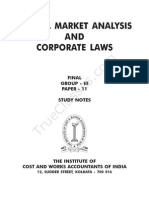QUIZ -1
1. By definition, currency appreciation occurs when :
a) the value of all currencies fall relative to gold.
b) the value of all currencies rise relative to gold.
c) the value of one currency rises relative to another currency.
d) the value of one currency falls relative to another currency
2. In the foreign exchange market, the ________ of one country is traded for the ________ of another
country.
a) currency; currency
b) currency; financial instruments
c) currency; goods
d) goods; goods
3. Suppose that the exchange rate between the dollar and the peso changed from 6 pesos per dollar to 8
pesos per dollar. This change means that the
a) peso appreciated.
b) peso depreciated.
c) dollar depreciated.
d) Both answers A and B are correct.
4. India is facing continuous deficit in its balance of payments. In the foreign exchange market rupee is
expected to
a) Depreciate.
b) Appreciate.
c) Show no specific tendency.
d) Depreciate against currencies of the countries with positive balance of payment and
appreciate against countries with negative balance of payment.
5. LIBOR is:
a) the interest rate commonly charged for loans between banks.
b) the average inflation rate in European countries.
c) the maximum loan rate ceiling on loans in the international money
d) the maximum interest rate offered on bonds that are issued in London.
6. For contingency exposure of foreign exchange, the best derivative that can be used to hedge is
a) Forwards.
b) Futures.
c) Options.
d) Swaps
7. Maintaining a foreign currency account is helpful to
a) Avoid transaction cost.
b) Avoid exchange risk.
c) Avoid both transaction cost and exchange risk.
d) Avoid exchange risk and domestic currency depreciation
8. A forward currency transaction:
a) Is always at a premium over the spot rate
�b) Means that delivery and payment must be made within one business day (USA/Canada) or
two business days after the transaction date
c) Calls for exchange in the future of currencies at an agreed rate of exchange
d) Sets the future date when delivery of a currency must be made at an unknown spot exchange
rate
e) None of the above is correct
9. The goal of a multinational corporation (MNC) is the maximization of shareholder
wealth. __________
10. A centralized management style, where major decisions about a foreign subsidiary
are made by the parent company, results in an increase in agency costs._________
11. Although MNCs may need to convert currencies occasionally, they do not face any
exchange rate risk, as exchange rates are stable over time._____________
12. When the dollar rises in value relative to a foreign currency, the current assets and
current liabilities of a U.S. foreign subsidiary increase in dollar value. _____________
13. A negative net foreign investment on this year's balance of payments
accounts means the country is a net debtor.__________
14. Because the balance of payments accounts must balance, sub-accounts like
the capital account must balance, too._____________
15. A firm's total portfolio risk may be reduced by investing in more than one
country.________
16. A foreign currency swap is simply an agreement between two parties to
exchange one currency for another at a yet-to-be-determined future date
but at a specified exchange ratio.____________
17. The spot rate is simply the exchange rate between two currencies as determined by
the respective governments.___________
18. Since there is a time value to money, the spot exchange rate of a currency is always
lower than the forward exchange rate.________________
� *************************
T , T, F, F, F, F, T, T, T, F

